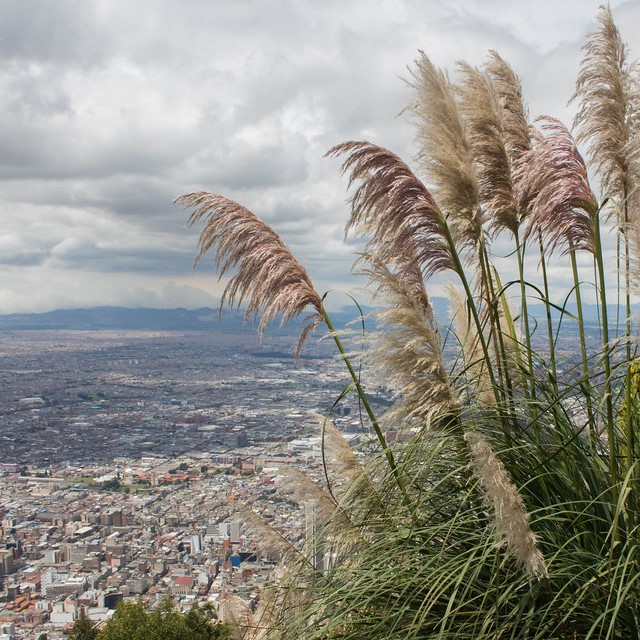A master's student at Universidad del Valle (Univalle) has used wind speed data from Colombian capital, Bogotá, to help unlock the secrets of how the tropical atmosphere works.
In the fields of climate modeling and climate change science, the dynamics of the tropical atmosphere are among the biggest uncertainties in future projections of global climate and looking for pieces of this puzzle are key to predicting the impacts of climate change.
Diego Andrés Arias Arana, a master's student at Univalle's School of Statistics explained that in his master's thesis "Spectral analysis for the detection and estimation of turbulent flows in non-stationary conditions," he is seeking to characterize the wind in the Bogota surface boundary layer that has been verified to exhibit non-stationary behavior, that is, it does not follow a stable pattern in a set period of time.
"If you have an ecosystem that has complex atmospheric behavior and you want to measure how much water vapor is coming into the atmosphere or measure how much carbon dioxide it is absorbing, it is important to adequately describe its nonstationary behavior," Arias said, adding that the hope is that in the future, tropical winds and their complicated behavior can be better represented in global climate models.
 |
| Photo: Diego Andrés Arias Arana, a student at Univalle's School of Statistics Credit: Diego Andrés Arias Arana |
Winds of Change
"In Bogota there are mountains, slow
winds and abrupt changes in wind direction so making measurements of wind
turbulence is challenging," Arias said, adding that 80% of the
measurements are non-stationary.
The measurements were recorded with a sonic anemometer, which does not measure wind with the movement of windmill blades but with ultrasonic sound waves that measure instantaneous wind speed.
Using these data, Arias' work focuses on advancing the mathematical analysis of the time series that define the turbulent fluxes of surface exchange with the atmosphere in terms of the spatial scales contained in the atmospheric fluid under all conditions.
"Our research proposal is based on presenting a statistical model that allows the study of non-stationary behavior of atmospheric turbulence time series," Arias said, adding that right now, non-stationary behaviors are left out of global climate models.
"Our work is to help fill these gaps in knowledge,'' Arias said.
Professor Rodrigo Jimenez of the National University of Colombia, who is in charge of the measurement project in Bogota and other parts of Colombia, explained that turbulence (fluid motion characterized by chaotic changes in pressure and flow velocity) is one of the great unsolved problems of physics.
"Understanding the turbulence structure of the atmosphere is very important and we are talking about almost totally unknown atmospheric environments: the tropical ones," said Prof. Jimenez, adding that in particular, Colombia's atmosphere is unique because it is equatorial and has a very complex wind structure.
"We aim to ... apply the eddy covariance technique under complex turbulence conditions," Professor Jimenez said, adding that complex turbulence is much more common in the tropics than in the mid-latitudes where this phenomenon has been more thoroughly studied.
Read more statistics stories: This Colombian Engineer Uses Logistics To Help Health Services Run Better
| Image: A sonic anemometer (in red) and other instruments to measure atmospheric conditions, in Bogota, Colombia. Credit: Edison Yesid Ortiz Durán. |
International collaborators
Professor César Andrés Ojeda Echeverry, tutor of Arias' master's degree in statistics, said Arias' work is a great achievement for Univalle and collaborators around the world.
"In terms of the importance of the work having a positive impact for the community, I think it would be vital for us because it justifies us as a public university and shows tangible results that respond to the effort and trust placed in us,'' said Professor Ojeda.
One of the collaborators is Dr. Javier Fochesatto, a researcher at the University of Alaska Fairbanks, who specializes in the study of the atmospheric boundary layer and surface-atmosphere exchange processes.
"It is important to consider the contributions of the interaction of the air mass with the surface on all spatial and temporal scales. In the temporal sense, when analyzing observations at a specific point the air mass has variable properties affected by the assembly of spatial scales embedded in the atmospheric fluid", said Dr. Fochesatto adding that a specialized modeling of the statistics that characterize this exchange is necessary and then based on a spectral estimation it would be possible to deduce the fraction of micro-scale contribution compared to those of regional scales.


Comentarios
Publicar un comentario